[Editor’s note: This major special feature ran two months ago in our newsletter INSIDER Xpresso. Our top content is now debuting first inside Xpresso. To gain the earliest access to our best content, join the free newsletter now! ]
IT WASN’T THAT LONG AGO THAT AMD stole Intel’s single-core performance crown with its Zen 3 chip architecture in the new Ryzen 5000 series CPUs. Now, less than a year later, Apple has come out with a chip (M1) that delivers a stunning performance of its own, and at least by one benchmark is the new reigning single-core performance champion.
But just how powerful is the M1 as compared to rival hardware options out there? And how well might this chip perform in CAD and 3D application environments? These were the questions I sought to answer ever since Architosh obtained a new (late 2020) Mac mini with an M1 processor.
I already knew Apple Silicon was a possible game-changer. And I had heard stunning praise from CAD industry software developers. But could a sub-1000 dollar machine really be a serviceable CAD/3D machine for professionals? After many benchmarks and real-world app tests (under Rosetta 2.0 no less), the short answer is “yes!”
Introduction: Tests and Machines
To back that “yes” up, I want to note that single-core performance is of the highest importance in the CAD world, particularly in AEC.
That is why the workstation folks over at BOXX aim architecture and engineering customers to high-frequency hardware solutions. For example, when speaking of Rhino, they say, “because modeling is its primary function, Rhino is a frequency-bound application, a key factor to consider when determining your Rhino 3D hardware requirements.”
FP performance is important to both 2D and 3D Vectorworks. It should help out in basic operations such as transformations, tessellation, projection of geometry entities in Vectorworks, as well as inside the Parasolid modeling kernel.
This is not to disregard multi-core processing. The M1 delivers very respectable multi-core performance, as we will see below. However, its single-core performance—thanks to Apple’s Firestorm cores—is quite astounding, besting AMD’s Ryzen 5000 series top-flight chip on Geekbench 5 scores.
The next most important thing to focus on is the M1’s GPU performance because today’s BIM solutions are more dovetailed with leading photo-realistic and interactive rendering programs. I wanted to focus on two aspects to see if the M1 could meet the minimum hardware requirements for Enscape (if that program ever comes to Mac) and meet the minimum specifications for standard VR headsets.
All in the Name
For industry benchmark testing suites, I only used those that are M1-capable (no Rosetta usage). For CPU, these included the well-regarded Geekbench 5 and Cinebench test suites. For GPU, I tested extensively on the GFXBench and Basemark test suites. There are other benchmarks Architosh has utilized in the past (like Blender Benchmark, Novabench, Unigine Heaven, XBench, et al.), but we are limited with those that are M1-native. One final note, we also did the browser application Speedometer 2.0 benchmark.
To test some real-world apps, we have some standard testing models for SketchUp (a frequency-bound, single-core-oriented app) and some Vectorworks Architect test files (see Part 2). This last app utilizes the Parasolid modeling kernel, the most popular geometry modeling kernel in the world. Both of these apps were tested under Rosetta, giving the M1 a disadvantage.
One final point. We did not have the latest iMac Pro to test against, so we are testing against the first generation iMac Pro (2017). We also tested against some circa 2017 HP Xeon and i7 workstations—all of which give us a pretty good idea of how a USD 700.00 machine stacks up against workstations costing many thousands of dollars.
The M1 — CPU Performance
All this testing is quite extensive. This article in Xpresso [Ed. note: this article ran originally in Xpresso] will not cover the full extent of our testing. Some of our testing we are holding off on until we can verify some details and others until we can obtain some Apple native versions of real-world apps.
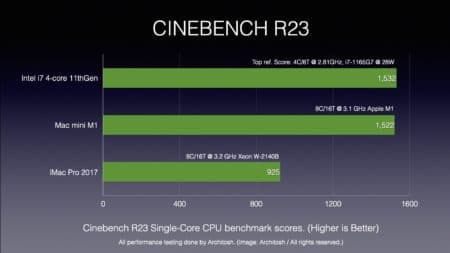
Cinebench R23, Single-Core CPU Test. Winner: M1 Mac mini defeats iMac Pro 2017. (Image: Architosh / All rights reserved.)
We will go through the testing results as briefly as possible and unpack these results with analysis. Do click on the charts to see data larger.
Cinebench
This benchmark focuses on single-core and multi-core CPU performance, using a CPU-bound renderer (Cinema 4D technology). The M1 Mac mini easily defeated my three-year-old iMac Pro in single-core tests, but the 2017 iMac Pro with an 8-core Xeon chip was approximately 26 percent faster at multi-core rendering. However, on single-core, the M1 was dramatically faster. (see image above and below.)
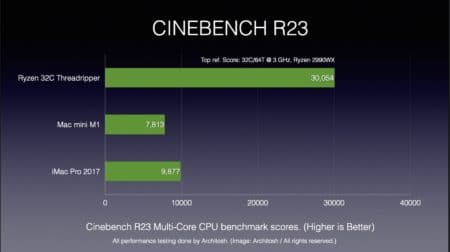
Cinebench R23, Multi-Core CPU Test. Winner: iMac Pro 2017 narrowly defeats M1 Mac mini. (Image: Architosh / All rights reserved.)
While Cinebench offers a sound sense of CPU performance, it doesn’t allow us to peek under the hood at various CPU performance aspects, like floating-point, an area critical to CAD, 3D, and scientific and engineering computing. This is where the GeekBench 5 test suite comes in handy.
GeekBench 5
Recently, I have come across some information from Nuvia, a young semiconductor design company headed by Gerald Williams, Apple’s former Chief CPU Architect, for nearly a decade. Williams led Apple’s A-series chip architecture designs. When he founded Nuvia in 2019, he took two other senior Apple chip design leaders with him, in Manu Gulati and John Bruno. I mention this not because I think Apple will suffer without Williams—not at all—but rather because these guys really know what they are doing. And they are big believers in Geekbench 5.
More than that, they have mathematically determined how to calculate very accurate approximations of SPEC CPU2006 and 2017 scores vis-a-vis Geekbench 5 scores. This an activity for a future article.
The Nuvia folks have written that Geekbench 5 scores are a good benchmark not only across platforms but also valid for server CPU load tests of a “comprehensive general nature.” In a nutshell, then, we should put excellent stock in the following Geekbench 5 numbers on the M1.
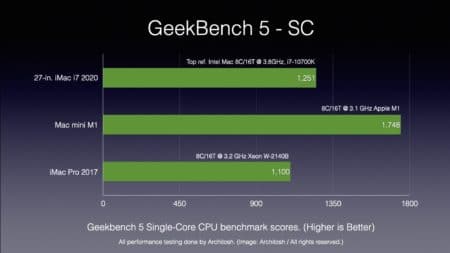
Geekbench 5 Single-Core Test. Winner: M1 Mac mini defeats the field. (Image: Architosh / All rights reserved.)
Again, we can see the M1 excels at single-core CPU performance, with a Geekbench 5 score 59 percent faster than the iMac Pro’s Xeon chip and 38 percent faster than today’s fastest single-core Intel Mac, the 27-inch mid-2020 iMac Retina, which uses the top 15th ranked single-core chip.
As a point of reference, Geekbench Browser lists top chip scores (reflecting averages of at least five unique results) with the AMD Ryzen 9 (5950X) 16-core chip obtaining an average score of 1685, slightly lower than the average of my M1 Mac test results. However, an iMacPro1.1 system is listed on the site with a score of 2278, using the same chip. We assume that Apple has built test units using AMD processors, but we can’t be sure.
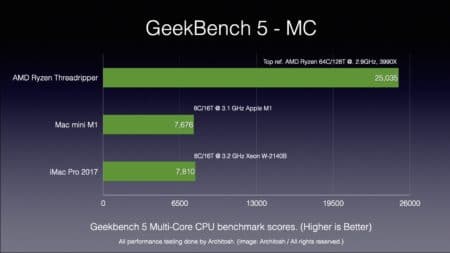
Geekbench 5 Single-Core Test. Winner: M1 Mac mini ties iMac Pro 2017. (Image: Architosh / All rights reserved.)
Again, we see that the M1’s weakness is its multi-core processing power, where four of its cores are dedicated energy-efficient Icestorm cores. It essentially ties Intel’s Xeon in the 2017 iMac Pro. As a point of reference, the fastest performer is AMD’s top 64-core Threadripper.
next page: The M1 — GPU Performance

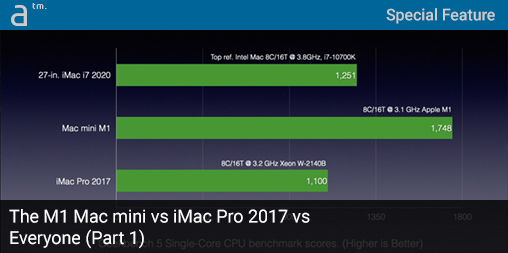


Reader Comments
Comments for this story are closed